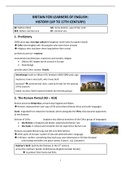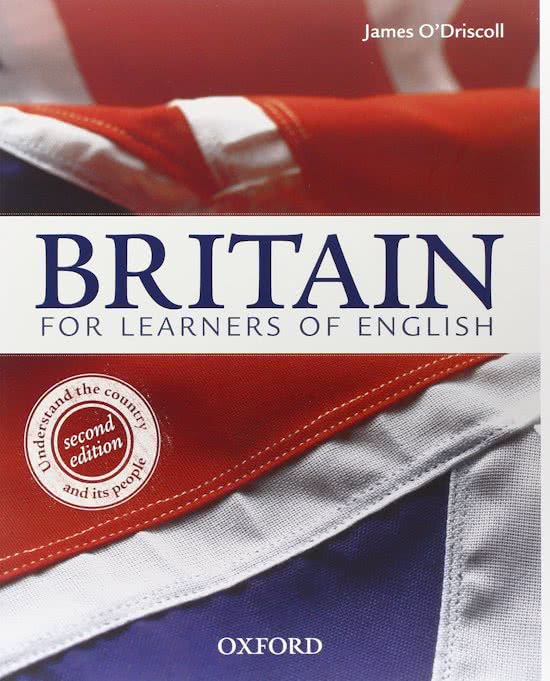BRITAIN FOR LEARNERS OF ENGLISH:
HISTORY (UP TO 17TH CENTURY)
BC: before Christ AD: ‘anno domini’, year of Our Lord
BCE: before common era CE: common era
1. Prehistory
2000 years ago: Iron Age culture throughout north-west European islands
➔ Celts intermingled with the peoples who were there already
➔ religious sites had been there long before their arrival
prehistoric period = mystery
monumental architecture: mysticism and esoteric religion
• Silbury Hill: largest burial mound in Europe
• Stonehenge
priestly caste Celtic society: Druids
Stonehenge: built on Silbury Hill, between 4300-5000 years ago
mysteries: how is was built, why it was built
purpose? ➔ astronomical clock, used by Druids for the passing
of the seasons
today: tourists, held in special esteem by minority groups
2. The Roman Period (43 – 410)
Roman province Britannica: present day England and Wales
➔ Romans imposed their own way of life and culture (Roman dress and Latin language)
Scots: migrated from Ireland to Scotland, where alongside the Picts, they became opponents
of the Romans
division of Celts: (explains two distinct branches of the Celtic group of languages)
• the Britons in England and Wales: experienced Roman rule
• the Gaels in Ireland and Scotland: did not experience Roman rule
Romans occupied Britain long, but left very little behind
➔ other parts of Europe: system of law and administration, language
➔ in Britain: neither, everything they built was soon destroyed or fell into disrepair
only lasting reminders are place names (‘castra’, e.g. Lancaster)
Hadrian’s Wall: built by the Romans in the 2nd century
across the northern border of Britannica (English-Scottish border)
➔ to protect from Scots and Picts
1
,3. The Germanic invasions (410 – 1066)
Anglo-Saxons: tribes from the European mainland (the Angles and the Saxons)
1) Anglo-Saxons had the south-east of the country in their grasp
2) were temporarily halted by an army of Britons under the command of King Arthur
3) by the end of the 6th century, their way of life predominated in nearly all of England
➔ Celtic culture and language only survived in Scotland, Wales and Cornwall
they introduced new farming methods and founded the thousands of self-sufficient villages
which formed the basis of English society for the next thousand or so years
King Arthur
popular history: folklore and myth
great English hero: Arthur and the Knights of the Round Table
medieval nobility and chivalry
lived long before medieval times and was a Romanized Celt trying to
hold back the advances of the Anglo-Saxons (who became ‘the
English’!)
Christianity: during 6th and 7th century, Christianity spread throughout Britain
a. south of England: Roman missionary St. Augustine
b. Scotland and northern England: from Ireland (became Christian 150 years earlier)
➔ Roman Christianity took over, but the Celtic model persisted in Scotland and Ireland for
several hundred years
➔ Celtic model: less organised, less need for a strong monarchy to support it
➔ secular and religious power more locally based and less secure in medieval period
Vikings, Norsemen or Danes (Scandinavia): invasions in the 8th & 9th century
9th century: conquered and settled the islands around Scotland and some coastal regions of
Ireland
➔ defeated by King Alfred of the Saxon kingdom of Wessex
cultural differences between Anglo-Saxons and Danes: very small
• same way of life
• different varieties of the same Germanic tongue
• Danes soon converted to Christianity
➔ similarities made political unification easier
➔ end of 10th century: England was an united kingdom (Germanic culture throughout)
➔ most of Scotland also united by this time = (Celtic) Gaelic kingdom
2
, King Alfred: ‘Alfred the Great’
able warrior, dedicated scholar (only English monarch who could
read and write) and wise ruler
burning the cakes: While he was wandering around his country
organizing resistance to the Danish invaders, Alfred travelled in
disguise. On an occasion, he stopped at a woman’s house. The
woman asked him to watch some cakes that were cooking to see
that they did not burn, while she went off to get food. Alfred
became lost in thought and the cakes burned. When the woman
returned, she shouted angrily at Alfred and sent him away. Alfred
never told her that he was her king.
4. The medieval period (1066 – 1458)
1066: Norman invasion of England ➔ western European culture
Scandinavian link remained in Scotland
• western isles: remained under control of Scandinavian kings until 13th century
• northern isles: remained under control of Scandinavian kings until 15th century
throughout this period, English kings also owned land on the continent, and were often at
war with the French kings
Norman invasion was small-scale ➔ Norman soldiers who invaded were given ownership of
the land and of the people living on it
strict feudal system imposed: ➔ start English class system
1) Great nobles or barons were responsible directly to the king
2) lesser lords (each owning a village) were directly responsible to a baron
3) under them peasants, ties by a strict system of mutual duties and obligations to the
local lord, and forbidden to travel without permission
peasants: English-speaking Saxons lords and barons: French speaking Normans
system of strong government ➔ made Anglo-Norman kingdom most powerful political force
in Britain and Ireland ➔ authority English monarchy gradually extended (controlled eastern
Ireland + Wales as well)
Scotland managed to remain politically independent in the medieval period, but was
obliged to fight occasional wars to do so.
250 years after Norman conquest: Middle English had become dominant language + Anglo-
Saxon concept of common law
Wales: never settled in great numbers by Saxons and Normans, so Welsh language and
culture remained strong
Ireland: were loyal to the English king, but adopted Gaelic language and customs
3





